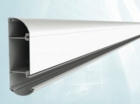Marco introduces new range of cable management trunking

Marco’s Elite range of uPVC trunking systems is available in three sizes (Elite 3, Elite Compact and Elite 60) to cover a variety of installation requirements. The sizes complement one another where more than one system is required.
The smallest of the range is the Elite Compact, at 145 x 50 mm. Its symmetrical curve design enables a large number of cables to be housed in installations where space is limited.
The Elite 3 measures 175 x 60 mm and also has a symmetrical curve design. It can house Cat5e, Cat6, shielded, Cat7 and Cat6a cables.
For quick and simple installation, the base and internal walls of Elite Compact and Elite 3 are prepunched. A hinged lid enables cables to be set into position easily without cable retainers. Both versions can accommodate the new open socket-mounting frames using, in the case of Elite Compact, the full 50 mm depth. They also allow for the use of deeper RJ45 modules.
Accessories include 2-piece adjustable bends for corners that are not 90°.
The largest of the range is the Elite 60, at 200 x 63 mm. A 50 mm minimum bend radius is provided for all fittings, including flat angles, tees, and internal and external angles. All cables can be laid into place without having to thread them through apertures.







